What is Media for Equity?
Media for equity is a way of financing by offering investors equity in return for marketing space. It is a different way of getting investments from the classical form of venture capital. The majority of investors investing via this model are media and advertising companies.
This allows start-ups to advertise their product without having to spend their cash reserves. And unlike other investments, a business sells its equity without getting any funding in the form of cash.
This also helps businesses increase their net sales and customers through media outlets without spending any budget on marketing and sales.
Before exploring media for equity, businesses should have a product or service to sell and a marketing campaign in mind, which could make looking for the right investor a bit easier.
If circumstance prevails, multiple media companies could align together for the specific requirement a company requires.
Doing media for equity for a start-up gives them a marketing space and vast exposure to venture capital for any future investments.
What is media for equity funds?
Media for an equity fund is similar to media for equity, where multiple media companies come together to fund a high-growth company and give it a media space.
Media company collaboration helps start-ups or businesses to have media outlets in various spaces, for example, television, billboards, etc.
Media-For-Equity And Its Relevance In The Business World
Media-for-equity is a financing model where companies trade equity to media conglomerates for advertising space. This model best suits scale-ups with limited company growth and expansion budgets. When successful, the media investment generates demand and sales, which leads to a higher company valuation, inherently driving revenue and long-term growth for the media group.
This model has been around for 30 years, but it is only recently that it has become popular worldwide. It was first implemented in Sweden and gained popularity in the DACH region in the 2000s.
A media-for-equity deal is generally a low-risk involvement for media groups. In some countries, including Sweden and the U.S., independent media-for-equity investment funds work with media groups to structure these deals. In other countries, such as Switzerland, the U.K. and Spain, media-for-equity investment funds are dedicated corporate investment arms of the media groups such as Ringier, BBC, ITV and Mediaset.
MORE FROMFORBES ADVISOR
When is the Media for Equity Model used?
The model can be used in the following scenarios:
When a start-up is just out of the developmental phase, marketing campaigns provide tremendous value by bringing a new customer base and a community, making your company name a known brand which further legitimizes the business and the product.
But marketing campaigns can be expensive and do not, in any way, provide a guarantee for returns through the number of sales; that’s when media of equity can be helpful.
Not only does the company receive accessible media outlets for its marketing campaign, but it also receives professional advice and support throughout the campaign’s making from the media companies investing.
In exchange, media companies receive a part of the company, which could provide a future investment return.
The model is also used when a start-up is having issues receiving investments through venture capital; having a media outlet and marketing campaign makes the company reasonable for investment for venture capital.
Does Earned Media Value Really Matter?
In today’s marketing environment, paid marketing campaigns have been trumped by the power of earned media. As a result, marketers are constantly trying to garner attention from their target audiences. But in a world where everyone has a voice, it’s not easy to get noticed.
Earned media campaigns occur more often than ever and are capable of reaching new heights if carried out strategically. That’s why EMV is a metric that is being increasingly used by brands.
Nevertheless, earned media value and marketers have a love-hate relationship. On one hand, EMV helps measure media mentions, but on the other, it doesn’t actually prove the success (or failure) of their efforts. Despite its flaws, earned media value remains a metric that is worth considering.
In our opinion, the key is to use EMW along with different metrics that together give you the big picture of a campaign’s results.
Read How to Track and Measure Paid, Earned, Shared, and Owned Media
So, how do you calculate the value of earned media?
Simply use other metrics to define your success. Our metrics to monitor to define success eBook collates the data you should be monitoring, to help you prove how your efforts are going. As a teaser, here are some alternatives to incorporate into your measurement strategy:-
Engagement
To counteract the risk that potential reach could potentially have, you should incorporate engagement metrics to help you understand how valuable a piece is.
Content that reaches a smaller, more engaged audience is much more valuable than content than reaches more people who are less engaged, so engagement metrics matter at this level.
It may not correlate directly with sales, but by measuring your engagement on a regular basis (and against your competitors), you can see more clearly how effective your strategy is working, and identify elements that you can replicate across the board.
Sentiment
Sentiment should also be incorporated into your monitoring where possible. Consider a content piece created by a third party, that’s shared fairly widely. Using a basic earned media value formula, you could see that as pretty valuable.
But what if it’s a negative review. One that could potentially damage your brand?
The EMV doesn’t factor this into its equation. And since negative sentiment can directly impact sales (and inversely, we can assume positive sentiment would too), it’s a metric that is more mature, and more valuable when it comes to reporting the impact of your efforts.

By looking at the sentiment spikes, you can quickly see if something is driving positive EMV or is actually detrimental to your brand.
Share of voice (SOV)
EMV gives you an idea about how many people are talking about your brand, but without setting a benchmark to see how that compares to your industry.
By adding share of voice into your mix, you can see how many mentions your brand is driving, and how that compares with your competitors.
For example, you could gain a mention on a popular blog, giving you a high earned media value. But if your competitors had the same luck at the same time, but with 3 times as many pieces, your message could be less valuable than you perceive. SOV helps you benchmark these levels.
And again, share of voice can directly be linked to market share, as per a case study from Millward Brown. Meaning it is a more mature metric, demonstrating the true impact of your marketing.
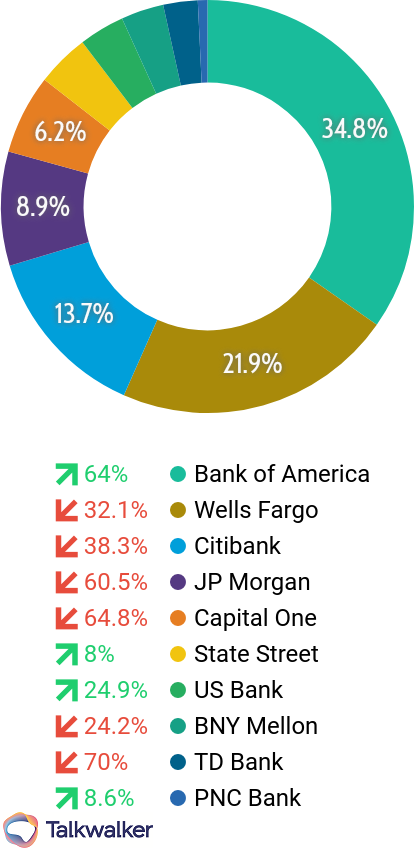
You need to assess how your competitors are performing to decide if your EMV is adding value to your business. Or just getting lost.
Are EMVs worthless?
Not at all. It’s great for giving you a general overview of your marketing, PR and media strategy efforts. But it isn’t very data mature.
Let me explain. Data maturity is all about aligning your data across your company to ensure all your efforts are leading to one main goal — typically, the success of the company.
EMVs are more of a stop gap. Yes, they can help measure your media mentions, but they don’t demonstrate impact. How did those results lead to sales, growth and success?
So, I’m not saying to not use EMVs. But instead, saying that you should dig deeper into the data, and combine them with other metrics so you actually can prove the value of your marketing efforts.
Is it Possible to Measure EMV Easily?
The good news is that yes, there is a way. The only thing you’ll need to do is use a media monitoring tool.
Such tools provide a new method for analyzing your EMV more effectively. You will gain insight into metrics that enable you to spot mistakes, improve your public relations and marketing strategies, plus fine-tune your performance.
Where to begin? Choose a media monitoring tool that best suits your needs. We can’t stop ourselves from listing the advantages of Determ here:
- Tracks 100+ million online sources 24/7
- Provides real-time alerts and tracks mentions in any country or language
- Easy to use and launch
- Has insightful, ready-made reports that help you to predict what will happen in the future
- Compare your results with the competition
- Helps you find social media influencers that will have an actual impact on your brand
 Determ
Determ
And what’s most important is that Determ streamlines your work and reduces your required effort to the absolute minimum.
Metrics for Measuring EMV
When it comes to earned media value, a media monitoring tool can help you track the progress of three different types of metrics that together give you a holistic view of where your EMV is at. Here’s an overview of each one.
1. Sentiment
Sentiment analysis is one of the most important metrics that you should keep an eye on. It helps you understand what emotions your brand evokes and how your customers perceive it.
You might assume that the traditional EMV formula shows that a particular piece of content was a success because it was widely shared. However, this could turn out to actually be far from the truth. Instead, the feedback received about it was rather on the negative side, and the brand’s reputation was hurt.
Since it is very difficult (if not impossible) to check and evaluate every mention, a media monitoring tool can be of great help in preventing such mistakes from occurring. Such a tool will automatically determine whether the sentiment of each mention is positive, neutral, or negative.
As a result, it is possible to focus only on opinions that are relevant to your brand’s image and identify any negative ones if and when they arise.
Read All You Need to Know About Brand Sentiment Analysis
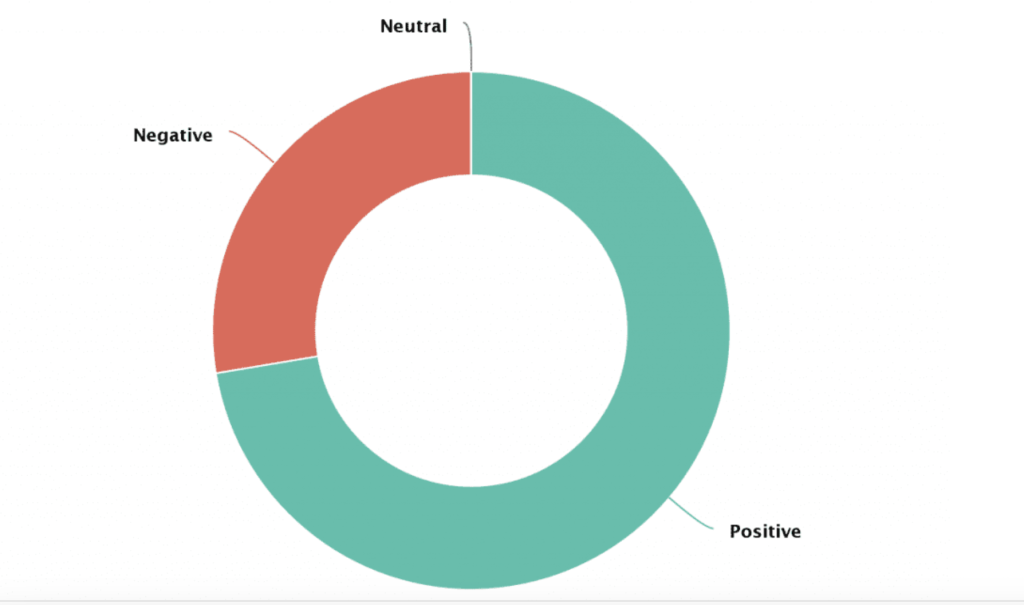 Sentiment analysis in Determ
Sentiment analysis in Determ
2. Engagement
Engagement metrics provide insights into how earned content resonates with the target audience and how valuable it is to them.
In terms of earned media value, the engagement metric is crucial. Content that is targeted at a smaller audience but is more engaging is far more valuable than that which reaches a broad yet uninterested group of people.
Keeping track of engagement regularly may not correlate directly with sales. However, by monitoring it regularly, you can see how effectively your strategy is working and identify components that could be improved or replicated.
 Photo by Kindel Media from Pexels
Photo by Kindel Media from Pexels
3. Share of Voice
Share of voice (SOV) illustrates your place on the market and shows how you rank against your competitors. You can use it to put earned media campaign results into context and know whether or not it generates satisfying results.
Read Share of Voice: How to Track It and Why
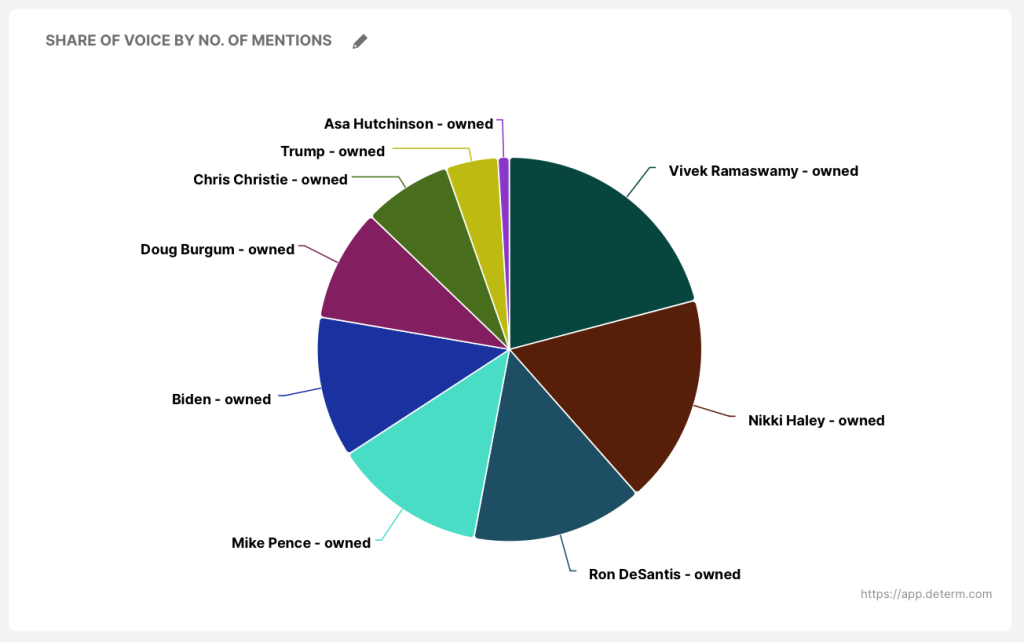 Share of voice between political competitors and their owned social media channels in Determ
Share of voice between political competitors and their owned social media channels in Determ
Influencer marketing also falls under the earned media category, and media monitoring tools provide SOV insights that let you know the results of such influencer marketing activities. In this way, you will be able to measure the impact of your collaboration with a particular influencer and decide whether further cooperation makes sense or not.
How to calculate earned media value
The first question is, how to measure earned media value? Much like advertising value equivalency (AVEs — another potentially misleading metrics), EMV is an attempt to provide a formulaic method of calculating your digital marketing strategy impact, by comparing it to similar media outreach.
The typical earned media value formula usually includes:
- A reach metric. Whether that’s potential audience, number of followers, impressions.
- Multiplied by an equivalent cost per thousand — so if you were measuring the reach of a Facebook campaign for example, you would use the cost per 1,000 impressions you’d expect from Facebook paid advertising.
- Multiplied by another factor depending on the use-case or person doing the conversion, to help align the results with the brand needs.

Here you can start to see the problems.
Three Tips To Take Into Consideration For A Media-For-Equity Deal
As exciting as media-for-equity is right now, there are a few things to consider.
1. Take time to get clarity on what you want to get out of the media deal and how it will blend into the company’s omnichannel growth strategy. Use Borderbridge’s insights and framework to discover the country-company-fit deal.
2. Ensure that your business is operationally ready to scale. Your company can generate a great deal of customer demand after taking this step, and you want to ensure that you’re prepared to handle that demand effectively.
3. Media-for-equity can be used to extend the runway of your company’s funding and adjust the existing budget. Accordingly, focus on building good unit economics. This usually enables a company to negotiate better percentage details with its next round of investors.
“Vanity metric voodoo”
“Earned media value (EMV) is one of those abstract marketing concepts that employs its own special form of vanity metric voodoo.”Jeff Ernst — CEO & President, Symec —
The issue with these earned media value equations, is that they rely on a lot of vanity metrics. Each of the above could help lead to misleading results —
Potential reach/impressions. This isn’t always the number of social media users that have seen your message. Just the people who may have done. We all know how we scroll through our social networks, and how quick those ads come and go. Did that impression really make a difference? Did a follower really see that post? If no, then how does that impact your brand?
CPM equivalent. With this, you’re comparing one value against another. It’s apples and oranges. Earned media works very different to advertising. 84% of millennials don’t trust advertising. Yet, coincidentally 84% of consumers trust peer recommendations above all other sources of advertising. By comparing the EMV of recommendations to ads on the same platform, you could actually be undervaluing your efforts.
Other factorials. And here’s where the distrust can come in. By adding in extra numbers, you risk massaging the figures to help demonstrate success without actually providing value to your company. It also makes it difficult to compare your different campaigns, if you use different factors across channels or regions.
What is ‘MIV®‘? A Deep Dive
Media Impact Value is a proprietary algorithm created by Launchmetrics to measure and benchmark the impact of all media placements and mentions across different Voices in the Fashion, Luxury, and Beauty industries.
This means that you can compare the Media Impact Value for each post shared across print, online and social channels. Thus, allowing you to measure the ROI of any marketing activity that you create and execute.
In our Top 20 Power Players in Luxury Fashion’s Leading Market report, we highlighted the top social posts by MIV in China, Europe, and the USA. For Europe, the top social publication by MIV was Millie Bobby Brown’s Instagram post for Moncler which accumulated $1.4M MIV from October to December 2020, and in China, the top social post was by 一坨小红花_ for Louis Vuttion at $577K MIV.
Using MIV as a benchmark metric, we are able to see that brands can view (in monetary terms) the buzz generated by celebrities and influencers wearing their creations, and compare the success strategies from one market to another.
Therefore, MIV allows your brand to compare results across various Voices, media types, channels, time periods, products, regions, and more. Moreover, the comparative capabilities mean brands can actually benchmark their performance against their competitors, as well as review omnichannel strategies to understand which channel or media type is overperforming or where there can be improvements.
How is it calculated? Which factors does the formula include?
Media Impact Value is based on 3 main criteria, starting with the advertising or activation value equivalent x source-based factors x content-based factors.
The advertising or activation value equivalent is calculated using advertising rates for print articles that are usually publicly shared by most publications in their official media rate cards. For an online article, this is rooted in the AVE where we rely on our learning set of more than 5,000 FLB online media publications with more than 10k brands that we have worked with. It is then adjusted based on the overall quality of mentions. This ensures that placements from more sought-after sources are valued more than less attractive sources. Across social, we consider the influence of a social account by individual metrics, such as the number of followers, likes, and shares across each platform. All in all, this criteria takes into account the audience as well.
‘Source-Based Factors’ reviews the media type, the relevance of content directly related to Fashion, Luxury, and Beauty topics, and the overall media quality score, looking at a set of 4k+ top media sources. For social, the post frequency is taken into consideration as well as the Voice type, whether the post comes from a celebrity, brand, influencer, or consumer.
‘Content-Based Factors’ takes into account engagement metrics (ex: likes and share counts) as well as the type of content. The length, size, positioning, and presence of images or videos can all make an impact on the content quality.
And thus, MIV is calculated with these main criteria in mind, but overall, it provides brands with a unified currency to measure the value of all marketing activities across Voices, Channels, and Markets by assigning a monetary value for each interaction and initiative. Thus, it makes it easy when benchmarking different activities from influencer marketing to PR endorsements. It is the true media value that helps you fully understand the ROI of your marketing and communication activations.

MEDIA IMPACT VALUE️: A GUIDE
By Gina GulbertiVICE PRESIDENT OF MARKETING
Gina is passionate about storytelling, creativity, and digital strategies. As Vice President of Marketing, she leads a rockstars team from the sunny city of Madrid! Being a crazy savvy marketer, in 2020 Gina co-founded the global community of b2bmarketers.com and currently combines all this activity, teaching Inbound Marketing in different business schools.
What is Earned Media
We must first explain why earned media is so important in order to gain a complete picture of your business. In contrast to paid media or owned media, earned media relies on third-party content to spread the word about your brand.
Simply put, earned media is the good or bad coverage you have “earned” as a brand. This type of content can therefore include infographics based on your own data or content contributed by your experts.
Similarly, earned media can also consist of discussions on forums, opinions, reviews, as well as social media posts and comments from your customers about your brand.
In short, earned media is any content that mentions your brand, product, or service outside of the channels you already operate on.
As this content is shared by existing clients, fans of the brand, and users, it helps establish relative trustworthiness in the eyes of potential customers. Rather than clicking ads or buying from commercials, people are more likely to buy products based on the recommendations of friends or experts.
This proves how vital earned media is to your business, by supporting the process of shaping and strengthening your brand awareness.
Read What Is Shared Media and Why It Matters for Your Brand
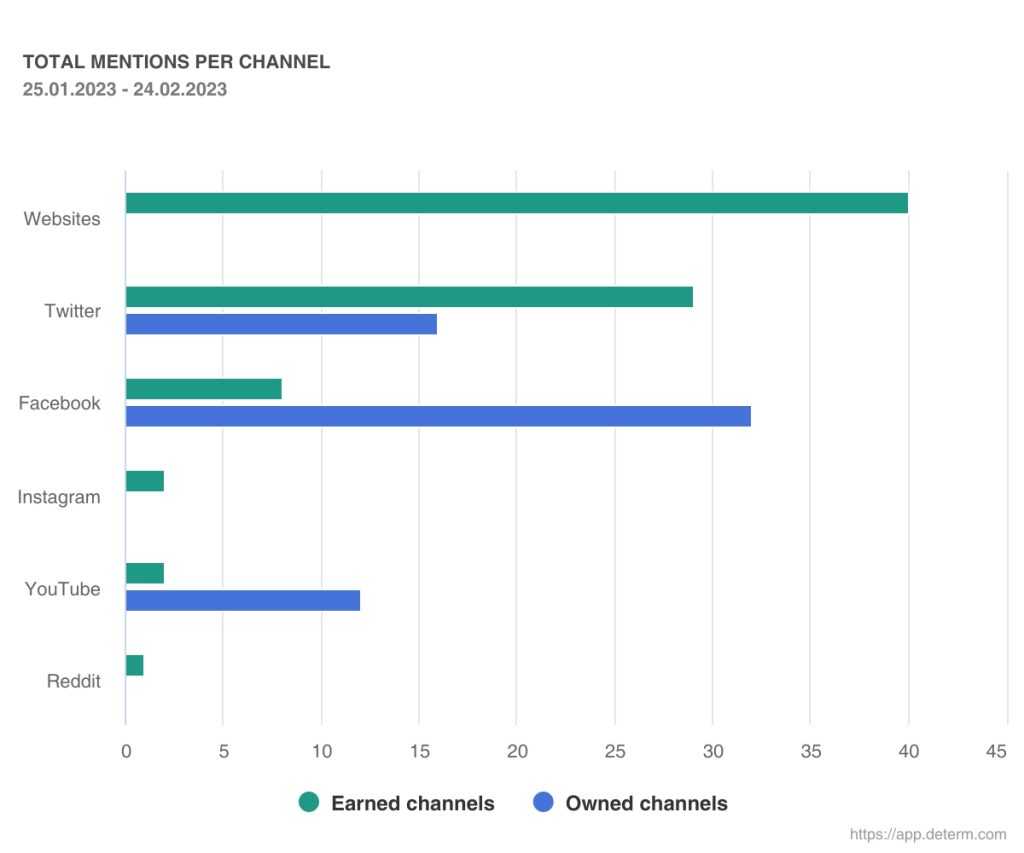 Earned vs owned channels in Determ
Earned vs owned channels in Determ
So, what is earned media value?
Earned media value (EMV) is a way of measuring the ROI of content gained through public relations (PR) and marketing activities.
EMV can serve as a helpful metric since it allows marketers to assign a numerical value to their efforts, providing better insight into how their campaigns are performing.
Unfortunately, this metric also has one notable downside. Many marketers believe that EMV is very subjective because there isn’t a standardized way to calculate it across the entire industry.
Research On Media-For-Equity And Its Global Impact
As can be seen, media-for-equity has potential, and that’s why I believe more business ecosystems need to learn about it.
Borderbridge published the first whitepaper on media-for-equity in 2021: «The Rise of Media for Equity» (download required). These and other insights have successfully supported the decision-making process in launching at least two media–for-equity funds that I know of: Fame Media Global in Singapore and Influencer Capital in Amsterdam. This year, Borderbridge published the «Global Media-for-Equity Report 2022» (download required), which uses over 50 interviews, 40 case studies and 793 investments from across the globe. Some key findings include the following.
• Startups that have traded equity in exchange for advertising in the last decade continue to lead with an 84% survival rate compared to the 10% industry average.
• At the seed and early-stage funding, media-for-equity investments are found to be an average of three times higher than VC investments.
• Ten new media-for-equity funds were established in the past three years.
But to me, the most significant conclusion of these reports is that media-for-equity has become a critical stage of development for many startups wanting to become unicorns.
What is earned media value?
Earned media value (EMV) is a method to calculate the importance of branded content gained through marketing or PR efforts, that is not paid media (not advertising) and not from owned (didn’t come from your media channels). This includes blogs, referrals, social posts, influencer marketing, reviews, and more.
Check out our Essential Guide | Paid vs earned vs owned media, for more details on the differences between each type of media.
The EMV formula can be useful for calculating your brands earned media (literally, your online word of mouth). But it has its pitfalls too. Any formula can be manipulated to justify the means, and EMV is no exception. To prove real success, you should never use it alone, but as part of an effective measuring and reporting strategy.
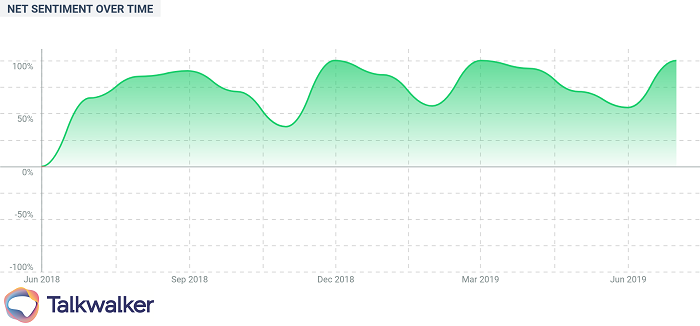
Are people falling out of love with earned media value? — Online mentions of EMV are pretty consistent, but the sentiment behind it is wavering.
Why was Media Impact Value™ created?
Media Impact Value was formulated to address some of the challenges that the Fashion, Luxury, and Beauty industries were facing when it came to measuring brand performance.
For example, the lines between print, online and social media have become increasingly blurry as well as the lines between paid, owned, and earned media. How can you compare a placement in Vogue’s September issue against a backstage Paris Fashion Week post on TikTok? Measuring these different media formats was difficult and almost incomparable.
In addition, reach and engagement metrics only highlight part of the story when measuring results. For example, a Micro Influencer with an extremely low engagement rate isn’t nearly as impactful as your own brand’s Instagram account. Quality definitely matters when it comes to measuring the value of any touchpoint or post.
Successes Of Media-For-Equity In Europe
Recently DMG Ventures’ investment in Cazoo was a real-life example of blitz-scaling. Cazoo went from the idea stage in December 2018 to launch in December 2019 to unicorn status in June 2020 to a $7 billion SPAC deal in March 2021. The company is now the fastest British business ever to have reached the rare and coveted unicorn status.
In Zalando’s case, arguably the most famous media-for-equity deal, the company has seen a staggering increase in revenue in the past four years. It’s even more impressive given that Zalando was founded a year before its media-for-equity deal, in 2008, similar to Cazoo.
Satispay followed a similar trail to Cazoo and Zalando. Founded in 2013 as a wallet-based payment solution for consumers independent of debit and credit cards, Satispay did a media-for-equity deal in 2020 with Ad4Ventures, the investment arm of the Mediaset Group. With its Series D fundraising round, it became the first unicorn company in Ad4Ventures’s investment portfolio and Italy’s second unicorn.
Media-For-Equity’s Benefits
Media-for-equity deals for B2C companies are a great way to start with traditional media. It can be an efficient way to raise brand awareness, increase market share and revenue and expand your business into new markets. The deal should integrate into an omnichannel growth strategy and benefit from media campaigns that span up to 24 months or longer. Scale-ups should explore the model at the product-market-fit stage.
Meanwhile, the media group can fuel innovation, diversify its revenue streams and generate an upside from all media inventory. The model enables the media conglomerates to go beyond their existing business model, expand their asset portfolio and build long-term resilience.

